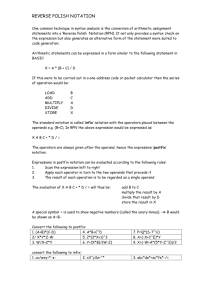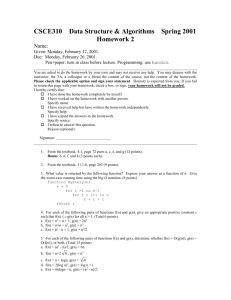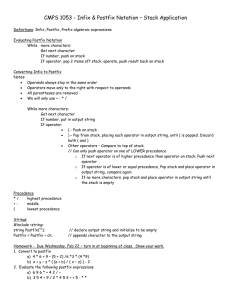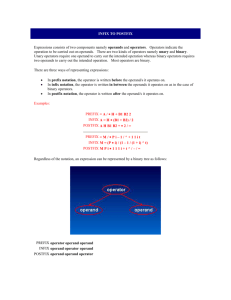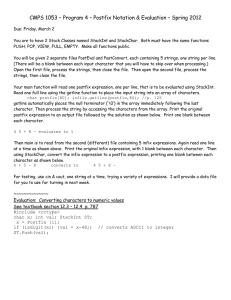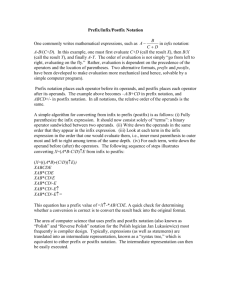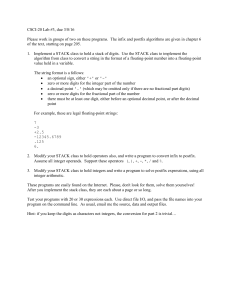Stack Data Structure: Applications & Expression Conversion
advertisement
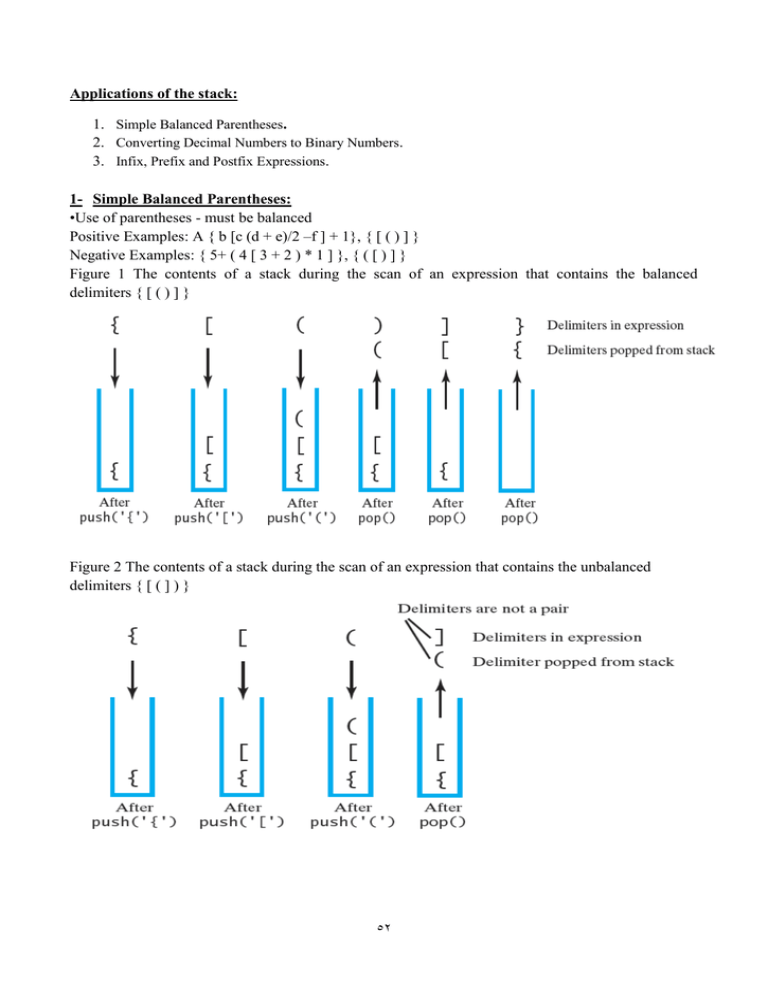
Applications of the stack:
1. Simple Balanced Parentheses.
2. Converting Decimal Numbers to Binary Numbers.
3. Infix, Prefix and Postfix Expressions.
1- Simple Balanced Parentheses:
•Use of parentheses - must be balanced
Positive Examples: A { b [c (d + e)/2 –f ] + 1}, } ] ) ( [ {
Negative Examples: { 5+ ( 4 [ 3 + 2 ) * 1 ] }, { ( [ ) ] }
Figure 1 The contents of a stack during the scan of an expression that contains the balanced
delimiters { [ ( ) ] }
Figure 2 The contents of a stack during the scan of an expression that contains the unbalanced
delimiters { [ ( ] ) }
25
2- Converting Decimal Numbers to Binary Numbers.
3- The Infix, Prefix, Postfix Notation:
Arithmetic expression: An expression is defined as a number of operands or data items combined
using several operators. There are basically three types of notations for an expression;
1) Infix notation 2) Prefix notation 3) Postfix notation
Infix notation: It is most common notation in which, the operator is written or placed in-between the
two operands. The expression to add two numbers A and B is written in infix notation as, A+ B In
this example, the operator is placed in-between the operands A and B.
Prefix Notation: It is also called Polish notation, refers to the notation in which the operator is
placed before the operand as, +AB As the operator ‘+’ is placed before the operands A and B, this
notation is called prefix (pre means before).
Postfix Notation: In the postfix notation the operators are written after the operands, so it is called
the postfix notation (post means after), it is also known as suffix notation or reverse polish notation.
The above postfix if written in postfix notation looks like follows; AB+
Notation Conversions: Let us take A+B*C = 2+3*5 = 5*5 = 25!!!!!!!! Is this the right result? No,
this is because the multiplication is to be done before addition, because it has higher precedence over
addition. This means that for an expression to be calculated we must have the knowledge of
precedence of operators.
Operator Precedence:
Operator
Exponential
Multiplication/Division
Addition/Substraction
Symbol
$
*, /
+, -
Precedence
Highest
Next highest
Lowest
25
3.1 Conversion from infix to postfix expression:
Algorithm
create empty postfix string
create stack S
for each symbol ch in the infix string do
if ch is an operand then
append it to the output postfix string
else
if ch = ( then
push ch onto stack S
else
if S = ) then
pop and append operators to output string until the matching ( is
encountered
else '(ch must be some other operator)
{
while stack not empty and prec(top(S)) ≥ prec(ch)
and top(S)<> ‘(‘ do
pop operator
append it to the postfix string
end while
push S
}
end for
while operator stack is not empty do
pop operator
append it to the postfix string
endwhile
Example: convert infix expression (A+B)*(C-D)/(E+F) to postfix.
1
2
3
4
5
6
7
8
9
10
11
12
13
14
15
16
17
18
infix
(
A
+
B
)
*
)
C
D
)
/
(
E
+
F
(
stack
(
(
(+
(+
(
*
*
*(
*(*(*
/
/(
/(
/(+
/(+
/
postfix
A
A
AB
AB+
AB+
AB+
AB+C
AB+C
AB+CD
AB+CDAB+CD-*
AB+CD-*
AB+CD-*E
AB+CD-*E
AB+CD-*EF
A B + C D - * E F+
AB+CD-*EF+/
25
3.2 Evaluating a postfix expression:
Algorithm for evaluating postfix expression:
Let P is an expression written in postfix notation.
1) STACK=empty stack.
2) Scan P from left to right and repeat step 3 and 4 for each symbol in P until end of expression.
3) If an operand is encountered, push it on STACK.
4) If an operator x encountered then;
a) Operand 2= pop (STACK).
b) Operand 1= pop (STACK).
c) Value= operand1 x operand 2.
d) Push value on STACK.
5) Return the value at top of the STACK.
6) Exit.
Example: Let us now consider an example. Suppose that we are asked to evaluate the following
postfix expression 6 2 + 5 9 * +.
22
3.3 Conversion from Infix to Prefix:
Algorithm for Infix to prefix:
reverse a given infix string
create empty reversed prefix string
create operator stack S
for each symbol ch in the reversed infix string do
if ch is an operand then
append it to the output prefix string
else
if ch = ) then
push ch onto stack S
else
if S = ( then
pop and append operators to output string until the matching ‘)‘ is encountered
else ' ch must be some other operator
{
while stack not empty and prec(top(S)) > prec(ch) and top(S)<> ) do
pop operator
append it to the reversed prefix string
end while
push S
}
end for
while operator stack is not empty do
pop operator
append it to the reversed prefix string
endwhile
reverse the reversed output prefix string
Example; (A-(B/C))*((D*E)-F)
25
3.4 Evaluation of prefix expression:
Algorithm
1) Read prefix string from right to left until there is a data.
2) Repeat;
If char is operand add to prestack
If char is operator
-operand 1= pop prestack.
-operand 2= pop prestack.
-result= value after applying operator between operand 1 and operand
-push the result into prestack.
3) pop prestack get required value.
Tracing +-*+12/421$42
Home Work:
1- Convert the following infix expression into postfix expression: (A+B)*C.
2- Evaluate the following prefix expression a) -/A$BCD where, A=2, B=1, C=4, D=3.
25
